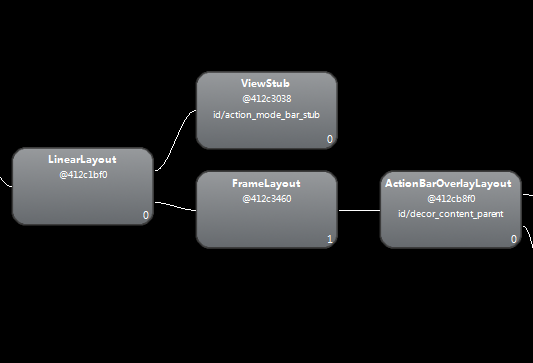ViewStub 的使用
一、内容概述
举例说明ViewStub标签的使用
二、ViewStub类的文档说明及应用场举例
文档描述:
A ViewStub is an invisible, zero-sized View that can be used to lazily inflate layout resources at runtime. When a ViewStub is made visible, or when inflate() is invoked, the layout resource is inflated. The ViewStub then replaces itself in its parent with the inflated View or Views. Therefore, the ViewStub exists in the view hierarchy until setVisibility(int) or inflate() is invoked. The inflated View is added to the ViewStub's parent with the ViewStub's layout parameters. Similarly, you can define/override the inflate View's id by using the ViewStub's inflatedId property. For instance:
<ViewStub android:id="@+id/stub"
android:inflatedId="@+id/subTree"
android:layout="@layout/mySubTree"
android:layout_width="120dip"
android:layout_height="40dip" />
The ViewStub thus defined can be found using the id "stub." After inflation of the layout resource "mySubTree," the ViewStub is removed from its parent. The View created by inflating the layout resource "mySubTree" can be found using the id "subTree," specified by the inflatedId property. The inflated View is finally assigned a width of 120dip and a height of 40dip. The preferred way to perform the inflation of the layout resource is the following:
ViewStub stub = (ViewStub) findViewById(R.id.stub);
View inflated = stub.inflate();
When inflate() is invoked, the ViewStub is replaced by the inflated View and the inflated View is returned. This lets applications get a reference to the inflated View without executing an extra findViewById().
上面的问题大致意思是:
ViewStub 是一种不可见且不占屏幕大小的View,它可以用于运行时延迟加载一个布局文件,当它的visibility被设置为View.visiable或者它的inflate方法被调用时
它所引用的布局文件就会被加载,接着ViewStub会用它加载的那个布局文件的View来替代自己。
在上面的例子中,我们可以用id为stub来findViewById,而当我们调用ViewStub.inflate()或者ViewStub.setVisiable(View.VISIABLE)时,那么它的将变成一个由mySubTree布局文件指定的View,而我们可以使用id为subTree去索引这个View。
应用举例:
如下是应用的布局框架,中间的那个FrameLayout正式我们当前Activity的布局,而上面就有一个ViewStub,具体它是系统用来干嘛呢,可以进一步查找。

三、我的demo
1. 定义一个用ViewStub延迟加载的布局文件,这里简单定义如下(headbar.xml)
<?xml version="1.0" encoding="utf-8"?>
<RelativeLayout xmlns:android="http://schemas.android.com/apk/res/android"
android:layout_width="match_parent"
android:layout_height="match_parent" > <Button
android:id="@+id/back"
android:layout_width="wrap_content"
android:layout_height="wrap_content"
android:layout_alignParentLeft="true"
android:text="back" >
</Button> <Button
android:id="@+id/go"
android:layout_width="wrap_content"
android:layout_height="wrap_content"
android:layout_alignParentRight="true"
android:text="go" >
</Button> <TextView
android:layout_width="wrap_content"
android:layout_height="wrap_content"
android:layout_toLeftOf="@id/go"
android:layout_toRightOf="@id/back"
android:text="as you see" >
</TextView> </RelativeLayout>
2.mainActivity的布局文件(activity_main.xml)
<RelativeLayout xmlns:android="http://schemas.android.com/apk/res/android"
xmlns:tools="http://schemas.android.com/tools"
android:layout_width="match_parent"
android:layout_height="match_parent"
tools:context="com.example.stubview.MainActivity" > <ViewStub
android:id="@+id/hiddenHead"
android:layout_width="wrap_content"
android:layout_height="wrap_content"
android:inflatedId="@+id/headbar"
android:layout="@layout/headbar" >
</ViewStub> <Button
android:id="@+id/show"
android:layout_width="match_parent"
android:layout_height="wrap_content"
android:layout_alignParentBottom="true"
android:text="加载View" /> </RelativeLayout>
3.mainActivity中的使用ViewStub 代码
@Override
protected void onCreate(Bundle savedInstanceState) {
super.onCreate(savedInstanceState);
setContentView(R.layout.activity_main);
findViewById(R.id.show).setOnClickListener(new OnClickListener() {
@Override
public void onClick(View v) {
ViewStub stubView = (ViewStub) findViewById(R.id.hiddenHead);
View view = stubView.inflate();
Toast.makeText(getApplicationContext(),
"hiddenHead View 的id为" + view.getId(),
Toast.LENGTH_LONG).show();
}
});
}
附代码参考https://github.com/LuLei2013/StubView.git
ViewStub 的使用的更多相关文章
- ViewStub的使用
ViewStub是一个不可见的.大小为0的控件,运行时ViewStub可以滞后加载.当ViewStub置为可见或者调用inflate()的时候,布局就会加载出来.用加载进来的布局取代ViewStub在 ...
- ViewStub源码分析
ViewStub是一种特殊的View,Android官方给出的解释是:一种不可见的(GONE).size是0的占位view,多用于运行时 延迟加载的,也就是说真正需要某个view的时候.在实际项目中, ...
- include、merge 、ViewStub
在布局优化中,Androi的官方提到了这三种布局<include />.<merge />.<ViewStub />,并介绍了这三种布局各有的优势,下面也是简单说一 ...
- Android实战技巧:ViewStub的应用
在开发应用程序的时候,经常会遇到这样的情况,会在运行时动态根据条件来决定显示哪个View或某个布局.那么最通常的想法就是把可能用到的View都写在上面,先把它们的可见性都设为View.GONE,然后在 ...
- ViewStub的简单用法和说明
最近无意间知道了ViewStub,所以特地的去了解了一下 都知道ViewStub是一个不可见的,大小为0的View,实际上跟include差不多,但是ViewStub要更加节约资源.被称为是" ...
- Android引导指示层的制作 (ViewStub + SharePreference)
引导指示界面是个什么鬼东西?一张图即明了:
- 【转】Android布局优化之ViewStub
ViewStub是Android布局优化中一个很不错的标签/控件,直接继承自View.虽然Android开发人员基本上都听说过,但是真正用的可能不多. ViewStub可以理解成一个非常轻量级的Vie ...
- Android性能优化之一:ViewStub
ViewStub是Android布局优化中一个很不错的标签/控件,直接继承自View.虽然Android开发人员基本上都听说过,但是真正用的可能不多. ViewStub可以理解成一个非常轻量级的Vie ...
- Android优化——UI优化(三)使用ViewStub延迟加载
使用ViewStub延迟加载 1.ViewStub延迟加载 ViewStub是一个不可见的,大小为0的View,最佳用途就是实现View的延迟加载,在需要的时候再加载View,可Java中常见的性能优 ...
- ViewStub的简单解析和使用场景
ViewStub是Android布局优化中一个很不错的标签/控件,直接继承自View.虽然Android开发人员基本上都听说过,但是真正用的可能不多. ViewStub可以理解成一个非常轻量级的Vie ...
随机推荐
- json数据格式了解
json数据格式介绍: https://en.wikipedia.org/wiki/JSON JSON(JavaScript Object Notation) 是一种轻量级的数据交换格式 json语法 ...
- Exchange2010启用反垃圾邮件功能
今天邮箱服务器发现有大量发件人为空的邮件等待执行,也就是说空邮件堵塞了队列. 一般来说,空邮件就是别人发送垃圾邮件给你,你的服务上不存在这个收件人,那么系统会产生一封退信告诉你这封邮件已经被退.而ex ...
- 12、Flask实战第12天:子域名
什么是子域名,我们的后台管理系统, 比如cms.heboan.com.配置子域名需要用到蓝图技术: 我现在buleprints下面创建一个cms.py 蓝图 from flask import Blu ...
- @RequestMapping注解的使用,Controller方法返回值
1,web.xml <?xml version="1.0" encoding="UTF-8"?> <web-app version=" ...
- 爬取维基百科人物介绍,并使用pymysql存储到数据库
代码如下: from urllib.request import urlopen from bs4 import BeautifulSoup import re import datetime imp ...
- 【mybatis】idea中 mybatis的mapper类去找对应的mapper.xml中的方法,使用插件mybatis-plugin
idea中 mybatis的mapper类去找对应的mapper.xml中的方法,使用插件mybatis-plugin,名字可能叫Free mybatis-plugin 安装上之后,可能需要重启ide ...
- 日积月累--exception记录
关于Android的sqlite数据类型text长度限制的问题? 这也许不能称为一个bug,但是比较坑,所以贴在了这里.在Android的sqlite中存储一个字符串,发现总是数据丢失,我去查询sql ...
- Mysql的共享锁和排他锁(转载)
mysql锁机制分为表级锁和行级锁,本文就和大家分享一下我对mysql中行级锁中的共享锁与排他锁进行分享交流. 共享锁又称为读锁,简称S锁,顾名思义,共享锁就是多个事务对于同一数据可以共享一把锁,都能 ...
- easyui textbox获取焦点事件
$('#textboxid').textbox().next('span').find('input').focus(); $('#id').textbox('textbox').focus();
- 初识JdbcTemplate
1.spring配置文件里注冊:參照使用 Spring jdbcTemplate 进一步简化 JDBC 操作 2.写javabean 3.写rowmapper(依据javabean来封装结果集) 4. ...
